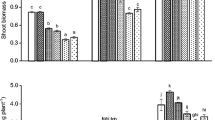Abstract
The relative efficiency of ortho and polyphosphates as P sources for wheat were studied in a field experiment with five sources—TSP, DAP, NP, APP (solid) and APP (Liquid) at three levels—13, 26 and 39 kg P ha−1 and the residual effect was studied on a succeeding cowpea (fodder). Both the crops were grown each year at same location. Wheat responded upto 39 kg P ha−1 in the first year but only upto 26 kg P ha−1 in the second year. The growth parameters—plant height and dry matter production and yield attributes-ears m−1, grains ear−1 and test weight were favourably influenced by P application. The rate of P uptake initially exceeded the dry matter production. Wheat when fertilized with 26 or 39 kg P ha−1 left behind a significant residual effect to raise the soil P availability and dry matter yield of cowpea. The grain yield of wheat was higher with APP's than with NP or DAP but the residual effect was the highest with NP. The magnitude of build up of soil available P with NP and APP's were similar and higher than DAP or TSP.
Similar content being viewed by others
References
Campbell CA, Read DWL, Winkleman GE and McAndrew DW (1984) First 12 years of a long—term crop rotation study in S.W. Seskatchewan-Biocarbonate—P distribution in soil and P uptake by the plant. Can J Soil Sci 64: 125–137
Engelstad OP and Terman GL (1967) Importance of water solubility of fertilizer. Fert News 12(7): 1–4
Fisher RA (1983) Growth and yield of field crops—wheat. In—Sym Pot Productivity Field Crops under Different Environments. 22–26 Sept. 1980, IRRI, Philippines, pp 129–154
Haynes RJ (1984) Lime and phosphate in the soil-plant system. Adv Agron 37: 249–315
Hossner LR and Melton JR (1970) Pyrophosphate hydrolysis of ammonium, calcium and calcium ammonium pyrophosphates in selected Texas Soils. Soil Sci Soc Am Proc 34: 801–805
Jackson ML (1967) Soil Chemical Analysis. Prentice Hall Inc. New Jersy, USA
Jung J and Jurgens—Gschwind S (1975) The fertilizing effect of condensed phosphates. Phosphorus Agric 64: 1–15
Khanna SS and Chaudhury KC (1979) Residual and cumulative effect of phosphatic fertilizers. Bull Indian Soc Soil Sci 12: 142–148
Knap WR and Kanp JS (1978) Response of wheat to date of planting and fall fertilization. Agron J 70: 1048–1053
Mishra B, Joshi MC, Sharma BL and Singh R (1986) Optimal water soluble P in NP fertilizers. Fert Agric 9: 23–28
Olsen SR, Cole CV, Wantabe FS and Dean LA (1954) Estimation of available phosphorus by extraction with NaHCO3. USA Circ 939
Peck TR, Kurtz CT and Tandon HSL (1971) Changes in Bray P-1 soil phosphorus test values resulting from applications of phosphorus fertilizers. Soil Sci Soc Am Proc. 35: 595–598
Prasad R (1980) Response of field crops to different fertilizers in India. In Holms JC, ed. Technology for increasing food production, pp. 228–236, Rome Italy
Prasad R and Aasum E (1985) The Norsk Hydro Nitrophosphate process in India—Aspects of agronomy, economics and technology. Fert Ind Ann Rev 8: 141–157
Prasad R and Dixit LA (1978) Fertilizers containing partially water soluble or no water soluble phosphate. Tech Bull, ICAR, New Delhi
Prasad R, Sharma SN and Dixit LA (1985) Phosphorus fertilization in an intensive annual cropping of wheat-greengram (or cowpea)-pearl millet. Fert Res 6: 219–224
Relwani LL (1961) Effect of tillage and manuring on the yield of wheat. Indian J Agron 5: 245–255
Romer W and Schilling G (1986) Phosphorus requirements of the wheat plant in various stages of its life cycle. Pl Soil 91: 221–229
Tandon HLS (1987) Phosphorus research and agricultural production in India. Ist edn. FDCO, New Delhi
Varvel GE, Merditch HL and Severson RK (1986) Field evaluation of acid-base fertilizer for spring wheat Agron J 78: 287–291
Westerman RL, Wood CI and Nurst R (1986) Response of winter wheat to surface split application of ammonium poly phosphate. J Fert Issues 3: 7–11
Author information
Authors and Affiliations
Rights and permissions
About this article
Cite this article
Venugopalan, M.V., Prasad, R. Relative efficiency of ammonium polyphosphate and orthophosphates for wheat and their residual effects on succeeding cowpea fodder. Fertilizer Research 20, 109–114 (1989). https://doi.org/10.1007/BF01055435
Received:
Accepted:
Issue Date:
DOI: https://doi.org/10.1007/BF01055435



